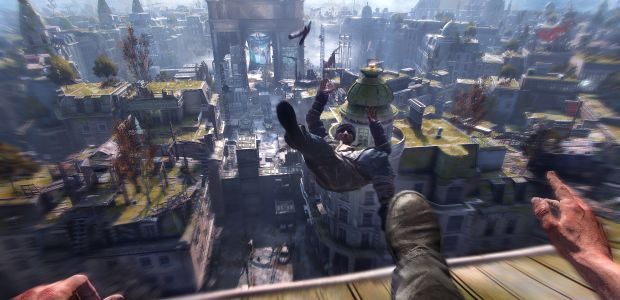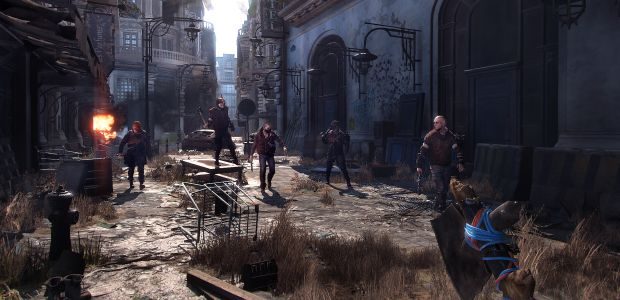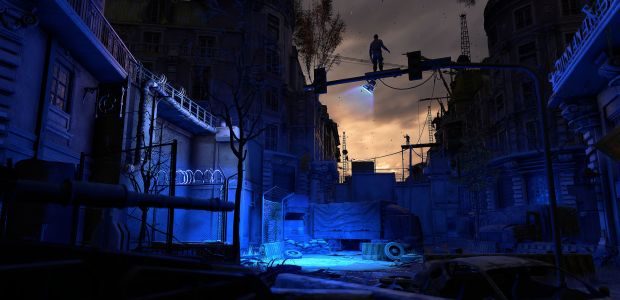Dying Light 2 is making the sun your new best friend
Blinded by the light
A room full of mannequins is rarely a safe place in videogames, but in Dying Light 2 it looks especially unnerving. Welcome to a zombie nest, where dozens of shamblers sleep during the day, huddling together in the shade of an abandoned clothes shop. They sleep upright, like decomposing commuters nodding off in a packed tube carriage. The best thing to do when you enter one of these “dark places” is to stay low, quiet and – oh god they’re awake get out get out leap through the window climb a drainpipe throw yourself through that door get back to the sunlight go go go.
Zombie parkour wizards Techland showed off a short Dying Light 2 demo during Microsoft’s conference at E3. But I went behind closed doors for a longer demonstration, helmed by lead designer Tymon Smektała. The takeaway: they’ve turned the dials up on everything. The sequel will have twice the amount of parkour manoeuvres, the urban map will be four times bigger, the day and night cycle has been re-worked, and it’ll have a city that changes based on which factions you suck up to. Get into bed with the strict Peace Keepers, for example, and you might find new shortcuts opening up faster routes across the city. Share your stained mattress with bandit groups and you’ll get a cut of their earnings as they exploit the survivors of the city for profit.
Basically, Techland want the story to react to you, rather than leading you down a narrow back alley full of uninspired talking heads. They seem to have acknowledged criticism of the previous game’s story, and have drafted in Chris Avellone to direct the forking paths of this one. But they’ve also got other scribes working on it, including Karolina Stachyra, one of the writers of the Bloody Baron quest in The Witcher 3.
But maybe you’re not here for a tale. Maybe you’re here to kick people off a roof. That’s what Smektała is soon showing me and an assortment of my fellow journo scum.
We see the player hopping across the cityscape (we didn’t get to play, just watch). It’s a fictional city but based chiefly on European architecture, with crumbling cathedrals, clock towers, neoclassical arches, and makeshift windmills. Fifteen years of apocalypse has turned this eurocity into an unkempt ruin. As Smektała puts it, we have entered a “modern dark ages”. We slide under railings, skip across the tops of lamp posts, balance on wires, swing from ropes, and slide down the front of a giant fabric advertisement. They’ve clearly aimed to build on the “floor is lava” conceit that our Adam loved so much from the original.
Later, we see our lad clambering up a water tower, a so-called “parkour puzzle”. This is a slower, more thoughtful ascent requiring lots of pausing and looking around for footholds and ledges. You have a stamina bar visible at all times, and some ascents will require pulling off multiple wallruns, leaps and grabs in a flawless sequence. It's the tower climbing we all know and lovehate, but with a robust library of parkour moves. The stamina bar seems there to keep you honest, a limitation Zelda players will know well.
“We had stamina in the first game as well,” says Smektała, “but it wasn’t used to the same extent.”
At first this seems like a concern. Why would you want a white bar holding your hands and feet hostage in a game that’s supposed to make you feel like a nimble chimney sweep? But the devs say it won’t be a constant presence. Parkouring across the city won’t normally require stamina, it'll only appear in stressful moments like chases or during those parkour puzzles. And this bar can be upgraded as you go along.
We keep climbing the water tower. Against convention, reaching the summit doesn’t result in a swirling camera or a splatter of icons on a minimap. Instead, the tower is home to a couple of angry fellas with sharp implements: two raiders called Jack and Joe who want a little chat. Some dialogue options appear. Depending on how you speak to them, you’ll either get into some fisticuffs or become best buds. In this demo, the developer elected to fight.
It’s the same weighty melee combat from before. Some very heavy attacks from the raiders knock our boy on his feet, but he scrambles back up and slashes back, cutting off a raider’s head with brutal, ridiculous efficiency. You’ll be able to pick up objects too, they say, objects like this bucket, which they launch at the skull of an enemy with comic force. Now our plucky roofhopper is bashing at the final baddie a few times, knocking him toward a ledge. He swings from a monkey bar and kicks him off the tower. It’s a fierce, scrappy little encounter and it takes enough effort that fighting more than two or three human enemies at a time looks to be a challenge.
Non-human enemies are another story. Zombies that hang out in the sun for too long become ravaged, weakened “degenerates” who can’t fight for spit. There are a few of these roaming the streets. But most zombies are now smart enough to keep out of the sun. They do this by hiding in “dark places”, indoor areas inhabited by crowds of the undead, slumbering during the day but out-and-about once night falls. Regular zombies have basically been given the sheltering instincts of the Volatiles from the previous games, nasty, speedy deadheads who pursued you at night but would run for shelter if the sun came up.
The clothes shop I mentioned earlier is one of these undead boltholes. The dev at the controls decides to creep inside this shop, to avoid a group of street thugs outside. At first glance, it’s hard to tell mannequin from maneater. The sound of snoring, grumbling zombies makes it clear there’s too many to take on by yourself. We’re told that these nests are good looting grounds, but to scavenge it properly it’s best to return when the sun is down and the decaying residents are out looking for their supper. For now, our hero tries to sneak through.
“Don’t shine your flashlight on them,” says Smektała. “Don’t get too close. Don’t make to much noise.”
But of course, they want to show off what happens when you do make noise. Our boy gets into a small scuffle and knocks over a shelf. The sleepers snap to attention. He quickly legs it, clambers to the top floor and busts out onto the rooftop, a final zombie giving chase. But when this last zed follows our lad out into the sun, it suddenly recoils in anguish, flailing its arms about and being generally unhappy. This is an interesting addition to the childlike rules of Dying Light’s world. Now, not only is the floor lava, but the light is a protective shield, your strongest ally in a world of shadow-dwelling monsters.
“In the first game, it wasn’t really that different,” says Smektała when I ask him about the revamped daily cycle. “During the day you had the zombies, and during the night you had the zombies and they were faster, and there was one new enemy type that could chase you around the level.
“What happens right now is the day is completely different from the night. The day is mostly for humans, it shows a more human side of our game in terms of narrative and also in terms of gameplay and combat and everything...”
As for those speedy perils of the night, the Volatiles, we didn’t see any. The sun stayed up throughout the demo, but it’s easy to guess that these scarier enemy types will be returning, accompanied by some other familiar and unfamiliar terrors.
The water tower dust-up wasn’t the only scrape our boy got himself into during the demo. Another encounter with some looters led to a hasty retreat across rooftops, the pursuers firing at him with arrows. This is a world in which guns have basically been lost to the ravages of armageddon. There’ll be bows and crossbows, but submachine guns and bazookas are a distant memory. Melee combat is definitely the focus. And if you don’t want to be dealing with hostile beardos all the time, you’ll have to make the city more secure.
Teaming up with the Peace Keepers is one way to do that. The developers fast forward in time and show us how the city changes when you sidle up to them. The streets are now patrolled by boys in blue with big sticks, keeping bandits away and clearing out “dark places”. Banners and warning signs are hanging in the streets, but so are a handful of bodies - the corpses of anyone who breaks Peace Keeper law. But they’ve also set up water fountains where you can replenish your health, thanks to that water tower we salvaged. And there are pulleys and lifts to make some climbs quicker. It’s that classic political trade-off: give up liberty and justice for comforts and "security". A fledgling authoritarian government.
But we’re also shown a glimpse of the thirsty world that would have been if we’d been friendlier to those looters in the water tower. Jack and Joe are now selling the water, which means no health-restoring fountains. However, since we’re complicit, we get a chunk of the proceeds. They've also set up some UV blockades - installments of UV lights that keep even regular zombies at bay.
“Everything flows in the right direction,” says one of the raider boys, handing over your cut of the water cash.
These bandits and Peace Keepers won’t be the only ones vying for control of the city’s resources, we’re told. It’s less like the two-sided turf wars of Far Cry and more a city of multiple neo-tribes, with your decisions about each piling up on top of one another.
“It’s not like you make a binary choice,” says Smektała. “Each decision yields different outcomes, and when you see those outcomes layering on top of each other, then you can get completely different combinations of gameplay elements and visuals in your city.”
I’m also told that each group will have attitudes and relationships with one another, sometimes hostile, sometimes not. It isn’t clear right now who else will show up, or how detailed this web of factions will be in practice, but one settlement we’re told can pop up (under certain conditions) is La Puerta, a black market of “advanced” weaponry and illegal substances. It might be worth getting these wheeler dealers on your good side, say the devs, so long as you don’t mind riling up the control-obsessed Peace Keepers.
It sounds ambitious, all these interlocking factions. But it also sounds like a good excuse to have those “what did you do?” conversations with friends. Of course, you could just drop into your friend's game, to see how their city is coming along. Up to four player co-op is possible, say the devs. Each player will retain their own version of the world, and you can enter your friend’s bandit-dominated cesspit, or invite them into your Peace Keeper “paradise”. In other words, someone will always act as host.
So far they seem to be ticking off every “could be improved” box from the first game. Another of the flaws of the first Dying Light was its overlong introduction. I ask Smektała if this is something they’ve tried to avoid in the sequel. Yes, they want to get to the fun parts a little faster, he says, but he also defends the need for at least some scene-setting.
“I think it’s quicker this time around, for sure, but I think a world like ours needs some introduction. We can’t just drop you in there and expect you to be able to survive and understand what is happening there, so there is a short introductory sequence where you learn who are and why you need to do whatever it is you need to do... Of course we don’t throw everything at you at the start of the game, but I think it will be quicker than the first game.”
Having seen all the rooftop perambulations they’ve got to show, I’m now deep in fishing-for-information mode. Smektała won’t say much about the competitive multiplayer side of things, but he does say to “expect some surprises”. I bring up Bad Blood, their upcoming standalone multiplayer game set in the same zedhell that will pit 12 people against one another in a not-quite-battle-royale stand-off. Smektała says this is something the team is “learning from”.
“As for Bad Blood, this is a smaller team that works within our Wroclaw studio, they sit basically desk to desk with us, so we exchange experiences and we see what they’re doing, we learn [from] what they’re doing, what kind of feedback they get from players… and also they can use our expertise… there’s plenty to share.”
He won’t say more than that just yet. Well, he does have one thing to offer: whatever PvP multiplayer they decide to have, it definitely won’t be a full fat battle royale.
“There’s no battle royale in Dying Light 2,” he says. “There are no plans to do this. That’s something I can say for sure. Because battle royale games, when you look at them, there’s one or two that are played by people. Of course the genre gets popular, but it gets popular because there are those behemoths that a lot of people play.
“I don’t think it’s good for the industry, for the market, for the games themselves, that every game has it. Because you cannot be master of everything. So in Dying Light 2 that is not our focus. That’s not the game we would like to make. If we [wanted] to make a battle royale game, then it would be a battle royale game, and not some narrative sandbox, complex stuff that also has a battle royale mode.”
Techland sounds like a studio that knows what it wants. It also seems to understand the power of harnessing simple fears, in a very Doctor Who way. They’re making a baddie out of darkness, a lava pit out of street level, and a useful pal out of sunshine. All of this within the traditional zombie apocalypse survival fantasy. Fans of the studio might lament the neglect of Hellraid, the magical dungeon crawler that was put on hold. (“It’s still in the freezer,” says Smektała when I ask about this. “Perhaps some day our CEO Pavel will say okay, it’s time to take it out of the freezer. I’m keeping my fingers crossed for this...”) But I’m happy to see Dying Light get a follow-up. Even if it does mean tip-toeing around in a shop full of mannequins and face munchers.
Check out our E3 2018 tag for more announcements, trailers, news, and goodness knows what else.


















